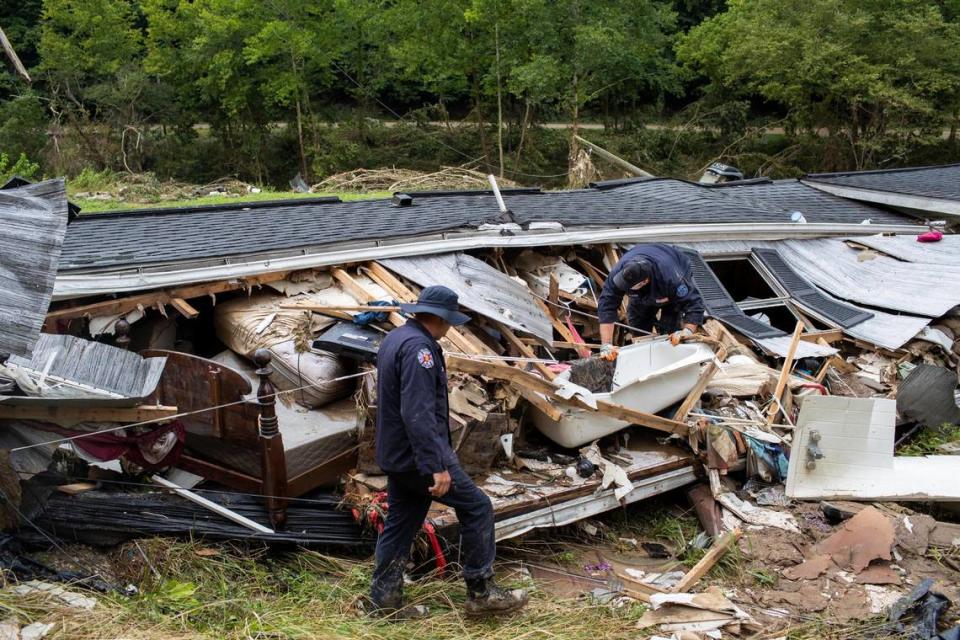‘It’s heartbreaking.’ How rising insurance costs could hurt Kentucky flood survivors
The average annual price of flood insurance for a single family home in Knott County — where 18 people died last summer in catastrophic flooding — has likely doubled in cost.
According to price projections released by FEMA in fall of 2022, the average cost of flood insurance for a single family home in the county would jump from $1,347 annually to $2,675. Flood insurance is managed nationally by FEMA, and in April the agency finished implementing a new pricing methodology called Risk Rating 2.0: Equity in Action.
That new pricing method is the subject of a lawsuit filed against FEMA last week by 10 states and several local governments. Kentucky is part of the suit asking a federal court in Louisiana to declare the new pricing method unlawful, Attorney General Daniel Cameron announced Monday. FEMA said it does not comment on active or pending legislation.
The average cost of flood insurance for a single family home in Kentucky will jump from just over $1,000 annually to more than $2,200, FEMA data showed.
“It’s not cheap to begin with,” Knott County Attorney Tim Bates told the Herald-Leader. Higher rates for flood insurance will discourage people from buying it, he said.
Those higher prices could be particularly troublesome for Kentuckians who accepted disaster aid from FEMA and are looking to rebuild their lives in flood-prone areas. FEMA requires those who receive post-flood disaster assistance from the agency to purchase flood insurance if they choose to build in a Special Flood Hazard Area.
Bates said he helped some people with their FEMA applications for flood assistance and in a couple of cases the applicants were denied assistance in 2022 because they received FEMA aid after flooding in 2002 but never bought flood insurance.
“Unfortunately I think some of those people just gave up,” rather than appeal, he said.

The vast majority of those impacted by last July’s deadly flooding did not have flood insurance. According to a report from the Ohio River Valley Institute, only 5% of the estimated 8,950 homes damaged were covered by flood insurance.
Whitney Bailey, a disaster resource attorney with AppalReD — which provides free legal service to those with low or fixed incomes across 37 different counties — said she has a “good handful” of clients who now are required to have flood insurance or risk not receiving aid in a future disaster. Many just simply can’t afford the insurance.
“It’s really frustrating for my clients to find out,” said Bailey, who specializes in helping clients with FEMA and other federal aid. “You know, they already can’t afford to pay for their groceries for the whole month or whatever else and now they have this flood insurance requirement.”
One client received about $900 from FEMA after flooding in 2021 came into their basement and damaged a washer and dryer, Bailey said. In last year’s flood, their home was completely destroyed.
They didn’t have flood insurance and because they’d already received aid the prior year, they were ineligible for the maximum $37,900 FEMA could provide in that situation, Bailey said.
“It’s heartbreaking to have to go through that process,” Bailey said.
Bailey said she’s pushing her clients who are ineligible for FEMA to apply for a disaster home repair grant from the USDA. Local long-term recovery groups and disaster case management agencies can also help. She encouraged any flood survivors still looking for help to keep trying.
“Don’t throw your hands up — keep pushing forward and let people help you shoulder the burden of your FEMA appeal or whatever other recovery issues you may have,” Bailey said.
On its website, FEMA said it opted to undertake the new pricing model to better address rate disparities between flood insurance clients. The previous model, created in the 1970s, used “static” data that emphasized a property’s elevation within a flood zone. The new model utilizes more flood risk data like the frequency and type of flooding.
Kentucky had about 19,400 National Flood Insurance Program policies, said a FEMA document from March 2021 explaining how the pricing model would work in the state. Of those policies — which include more than just single family homes — 29% were expected to see an immediate decrease.
“FEMA recognizes and shares concerns about flood insurance affordability for those who need it,” the agency said in a statement to the Herald-Leader. “In 2018, FEMA delivered an Affordability Framework to Congress for consideration. Only Congress has the statutory authority to consider affordability in setting rates.”
Increasing access to flood insurance is a “priority” for the Biden-Harris Administration, FEMA said.
“The administration continues to include an affordability proposal for flood insurance in the proposed budgets submitted to Congress,” FEMA’s statement continued.
FEMA has done good work for some folks in Eastern Kentucky following the floods, Bailey said, but the new pricing policy may need to be reconsidered.
“I’m thankful for everything FEMA has done for some of our clients in the area,” Bailey said. “And I do believe that their heads are in the right place with wanting to rework the system. But as it stands… I don’t think a blanket application makes sense in this case. Because you’re not factoring in a normal person who can’t afford a lot of these extra luxuries. I feel like flood insurance is kind of a luxury.”
In 11 of the 13 counties that were eligible to receive FEMA aid after the deadly July 2022 flooding, the average estimated flood insurance cost for a single family home would go above the state average of $2,200.
Martin County, which has some of the state’s highest poverty rates, would have the highest average costs in the state with insurance for a single family home coming in at just over $4,500 annually.
Herald-Leader reporter Bill Estep contributed reporting.

